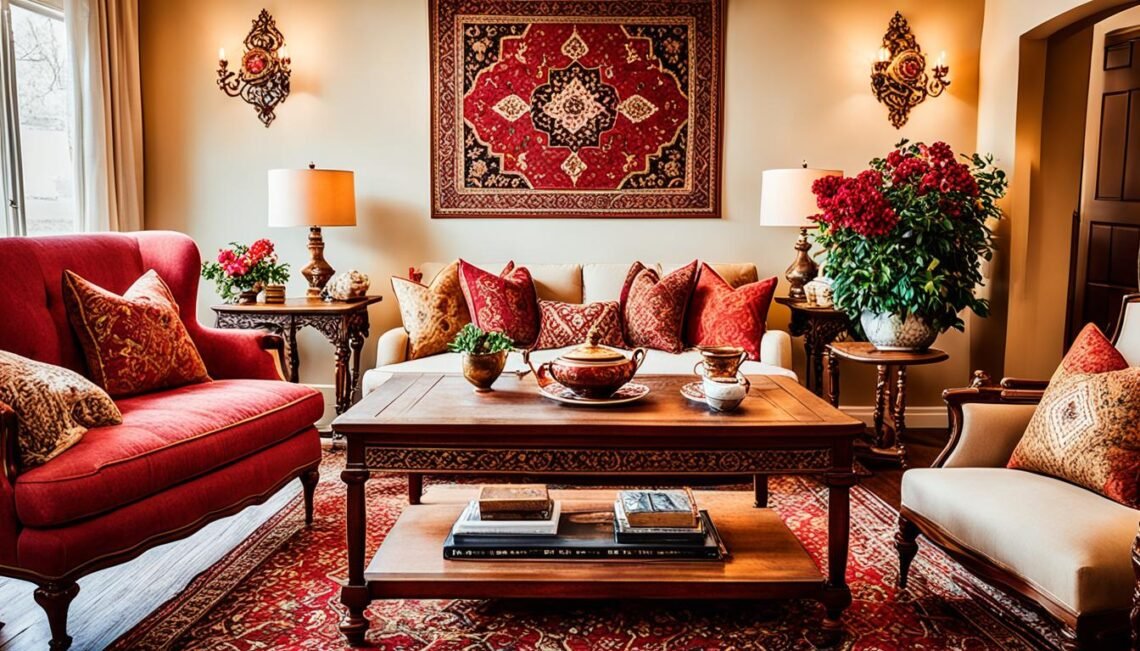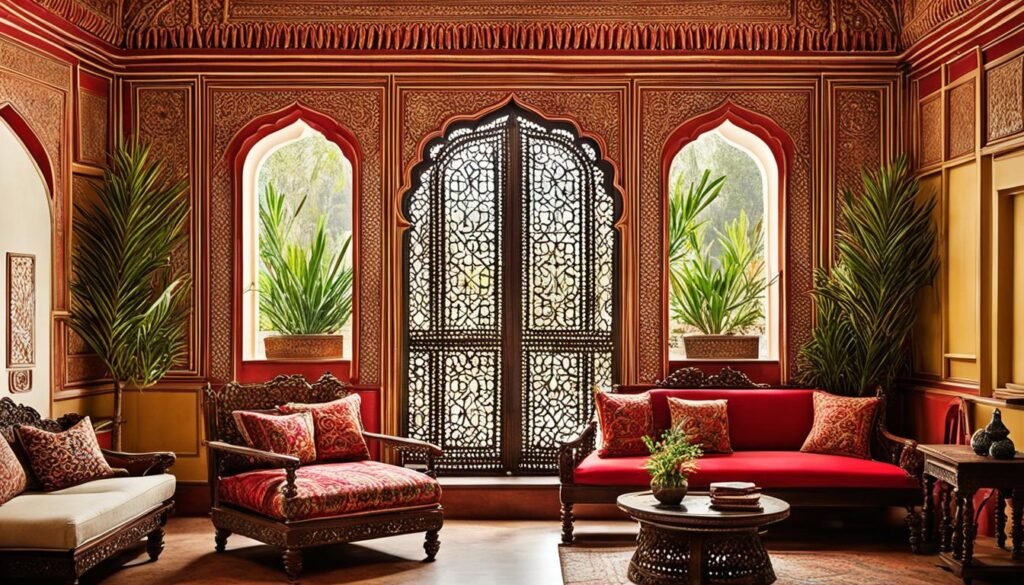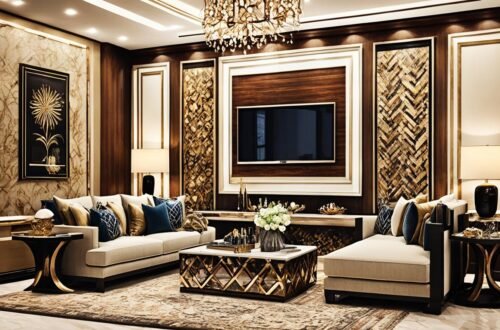
Interior Design Meaning in Urdu Explained
In this section, we will explore the meaning of interior design in Urdu and provide translations and definitions to help you understand this creative field in the Urdu language.
Interior design, or “اندرونی ترتیب” in Urdu, refers to the art and science of enhancing the interior spaces to create aesthetically pleasing and functional environments. It involves the thoughtful arrangement of furniture, colors, textures, and accessories, along with consideration of lighting, acoustics, and spatial planning.
Understanding the concept of interior design in Urdu will allow you to communicate effectively about your design preferences and collaborate with professionals in the field. It enables you to appreciate the power of design in shaping the atmosphere and ambiance of a space.
By learning the Urdu translation of interior design terms and concepts, you can unlock a whole new world of creative expression and enhance your understanding of this exciting discipline.
Key Takeaways
- Interior design in Urdu is referred to as “اندرونی ترتیب” and encompasses the art and science of creating visually appealing and functional spaces.
- Understanding interior design in Urdu helps in effective communication and collaboration with professionals in the field.
- Exploring the Urdu translation of interior design terms expands creative expression and enhances understanding of this discipline.
Exploring the Essence of Interior Design in Urdu
In the realm of interior design, the artistic arrangement and transformation of spaces elevate the experience of the built environment. This discipline encompasses a range of principles and elements that play a pivotal role in shaping rooms into captivating, functional, and aesthetically pleasing havens.
When it comes to interior design, understanding the core principles is essential for creating harmonious compositions that balance form and function. Whether it’s the strategic use of color, texture, or lighting, every element contributes to the overall ambiance of a space.
For those passionate about exploring the intricacies of interior design and honing their creative skills, there are various avenues to pursue. Online interior design courses offer convenient and flexible learning options, allowing enthusiasts to dive deep into the subject without geographical constraints. Additionally, for individuals fluent in Hindi, there are specialized interior design courses available in the Hindi language, making it more accessible and relatable.
These courses provide invaluable insights into the technical and theoretical aspects of interior design, covering topics such as space planning, material selection, and design concepts. By enrolling in these courses, aspiring interior designers gain a solid foundation while learning from industry experts.
Let’s explore the essence of interior design further and discover how this creative discipline nurtures ingenious ideas, transforms spaces, and brings dreams to life.
The Core Principles of Interior Design
The field of interior design revolves around fundamental principles that guide the creation of inviting and functional spaces. Each principle contributes to the overall aesthetic and sets the stage for seamless integration of design elements. Here are some key principles to consider:
- Balance: Achieving visual equilibrium through the careful distribution of weight, color, and texture.
- Unity: Creating a harmonious composition by unifying different design elements.
- Rhythm: Establishing a sense of movement and flow within a space.
- Proportion and Scale: Ensuring visual balance by considering the size and relationship of objects within a room.
- Contrast: Adding visual interest and depth by juxtaposing different elements.
- Emphasis: Highlighting focal points and creating visual hierarchy to guide the eye.
By understanding and applying these principles, interior designers can create captivating spaces that evoke specific emotions and cater to the needs and preferences of their clients.
“Interior design is the art of harnessing the power of space, color, and form to create extraordinary environments that leave a lasting impression.” – Unknown
Exploring Design Elements in Interior Design
Interior design is enriched by various design elements that contribute to the overall aesthetic and functionality of a space. These elements serve as building blocks to create visually engaging and purposeful interiors. Here are some essential design elements:
| Design Element | Description |
|---|---|
| Color | The use of hues, tints, and shades to create mood, evoke emotions, and establish visual appeal. |
| Texture | The tactile quality of surfaces, adding depth, interest, and sensory experience to a room. |
| Lighting | The strategic arrangement of light sources to enhance the overall ambiance and functionality of a space. |
| Pattern | The repetition of motifs or designs to add visual interest and create a cohesive look. |
| Furniture | The selection and arrangement of furniture pieces that cater to the functional and aesthetic requirements of a space. |
| Accessories | The curated collection of decor items that add personality, style, and a finishing touch to a room. |
These design elements work in harmony, complementing each other to build visually captivating and functional spaces.
Understanding the core principles and design elements is an essential foundation for anyone looking to embark on a career in interior design. By honing these skills and exploring the essence of design in Urdu, individuals can create enchanting and transformative spaces that elevate the human experience.
Cultural Influence on Interior Design in Urdu
When it comes to interior design, cultural influences play a significant role in shaping the style and aesthetic of a space. In India and Hindi-speaking regions, these influences are particularly strong, resulting in unique and diverse interior design styles. From the vibrant colors of Rajasthan to the intricate patterns of Mughal architecture, the cultural tapestry of India is intricately woven into its interior design.
“The fusion of tradition and modernity is a hallmark of Indian interior design. It seamlessly blends ancient cultural elements with contemporary design concepts, creating spaces that are rich in heritage yet infused with modern sensibilities.” – Karishma Sharma, Interior Design Expert
One notable characteristic of Indian interior design is the use of contrast. Vibrant colors are often juxtaposed with earthy tones, and traditional motifs are incorporated into contemporary furniture and decor. This contrast not only adds visual interest but also reflects the diverse and dynamic cultural landscapes of India.

Popular Interior Design Styles in India
India boasts a rich diversity of interior design styles that are deeply rooted in its cultural heritage. Some of the most popular styles include:
- Rajasthani: Inspired by the royal palaces and forts of Rajasthan, this style features vibrant colors, intricate carvings, and luxurious textiles.
- Mughal: Influenced by the historical architecture of the Mughal empire, this style showcases intricate arches, ornate details, and elegant marble.
- Colonial: Reflecting the British colonial era, this style combines traditional Indian elements with European influences, featuring dark wood furniture and classic patterns.
- Contemporary Indian: This style embraces modern design principles while incorporating traditional Indian motifs, creating a harmonious blend of past and present.
These interior design styles in India not only serve as a reflection of the country’s rich cultural heritage but also provide a platform for creative expression and storytelling.
In Hindi-speaking regions, there is a unique interior design style that reflects the language and traditions of the Hindi-speaking community. This style incorporates elements such as Devanagari script-inspired artwork, Hindi typography, and traditional motifs that hold cultural significance.
The Role of Contrast in Interior Design
Contrast plays a crucial role in interior design as it creates visual impact and adds depth to a space. Whether it is the contrast between light and dark, bold and neutral colors, or traditional and contemporary elements, it helps in achieving a balanced and visually appealing interior.
“Contrast not only brings a sense of drama and excitement to a space but also highlights the unique features and details that make it special.” – Priya Singh, Interior Designer
Using contrast effectively can transform a room from dull to dynamic, creating focal points and visual interest. It allows different design elements to stand out and ensures that each element is given its due attention.
Creating Culturally Rich Spaces
By incorporating cultural influences and utilizing contrast, interior designers can create spaces that are not only visually stunning but also culturally rich. These spaces celebrate heritage, tell stories, and provide a sense of belonging.
From traditional Indian design styles to the fusion of contemporary and Hindi-inspired elements, interior design in Urdu-speaking regions showcases a beautiful blend of cultural influences and modern sensibilities.
| Interior Design Styles in India | Key Features |
|---|---|
| Rajasthani | Vibrant colors, intricate carvings, luxurious textiles |
| Mughal | Intricate arches, ornate details, elegant marble |
| Colonial | Blend of traditional Indian and European influences, dark wood furniture, classic patterns |
| Contemporary Indian | Modern design principles with traditional Indian motifs |
Key Principles and Techniques in Interior Design
When it comes to interior design, there are key principles and techniques that serve as the foundation for creating stunning and functional spaces. These principles not only guide designers in their creative process but also ensure that the final result is visually appealing, harmonious, and balanced.
The Elements of Design
One of the fundamental aspects of interior design is understanding the elements that make up a space. These elements include:
- Color: The use of different colors can evoke various emotions and set the mood for a room.
- Texture: Incorporating different textures adds depth and visual interest to a space.
- Pattern: Patterns help create a cohesive aesthetic and add personality to a room.
- Light: Proper lighting can enhance the ambiance and highlight focal points in a space.
- Line: Lines can create movement and guide the eye throughout a room.
Scale and Proportion
Two important concepts in interior design are scale and proportion. Scale refers to the size of objects and how they relate to each other and the space they occupy. Proportion, on the other hand, deals with the relationship between different elements in terms of size, shape, and quantity.
Properly understanding and applying scale and proportion can create a sense of harmony and balance in a room. It ensures that no element overpowers or underwhelms the overall design, resulting in a space that feels visually pleasing and well-proportioned.
Harmonizing Colors
Color plays a crucial role in interior design and has the power to drastically transform a space. By understanding color theory and the psychology behind different hues, interior designers can effectively select and combine colors to achieve the desired atmosphere and mood.
Creating Focal Points
Focal points are essential in interior design as they draw attention and create visual interest. These can be achieved through various design elements such as artwork, architectural features, or statement furniture pieces. By strategically placing focal points, designers can guide the viewer’s gaze and create a captivating focal point that anchors the entire space.
Mastering these key principles and techniques in interior design is crucial for creating beautiful and functional spaces. By understanding the elements of design, utilizing scale and proportion, harmonizing colors, and creating focal points, designers can craft spaces that are visually striking and tailored to meet the needs and desires of the occupants.
Conclusion
In conclusion, interior design plays a significant role in Urdu-speaking regions, as it helps to shape and transform spaces into aesthetically pleasing and functional environments. By incorporating cultural influences and embracing local design elements, interior designers in Pakistan have been able to create unique and vibrant styles that reflect the rich heritage of the country.
Looking ahead to the future, we can expect interior design trends to evolve in the coming years, with 2024 and 2025 bringing new possibilities and innovations to the field. Pakistani interior design is likely to continue embracing a blend of traditional and contemporary elements, resulting in dynamic and visually striking spaces.
For aspiring interior design professionals, the future looks promising. With the growing popularity of interior design in Urdu-speaking regions, there will be increasing demand for skilled individuals who can create spaces that are both visually appealing and functional. This presents abundant opportunities for those passionate about interior design to carve out successful careers in the industry.
FAQ
What is the meaning of interior design in Urdu?
The meaning of interior design in Urdu refers to the creative process of designing and enhancing the interior spaces of a building to achieve functionality, aesthetics, and an optimal living or working environment. It involves the arrangement of furniture, color schemes, lighting, and other elements to create visually appealing and harmonious spaces.
Can you provide the Urdu translation of interior design?
The Urdu translation of interior design is “آندرونی تجویز”.
How would you define interior design in Urdu?
Interior design can be defined in Urdu as “آندرونی تجویز کرنے کا فن” or “بازار کی سینکڑوں چیزوں کو استعمال کرکے آپ کے گھر کی خوبصورتی اور آرام بڑھانا”.
What is the concept of interior design in Urdu?
The concept of interior design in Urdu centers around the idea of transforming interior spaces into aesthetically pleasing and functional environments through the thoughtful arrangement of elements such as furniture, colors, textures, and lighting.
What is the Urdu word for interior design?
In Urdu, the word for interior design is “آندرونی تجویز” or “گھر کی زیبائش”.
What are the key elements of interior design?
The key elements of interior design include space, line, form, color, texture, pattern, and light. These elements are combined and manipulated to create visually appealing and functional spaces.
What are the fundamental principles of interior design?
The fundamental principles of interior design include balance, scale and proportion, rhythm and repetition, emphasis and focal point, harmony and unity, and contrast. These principles guide designers in creating harmonious and well-designed spaces.
How does scale play a role in interior design?
Scale in interior design refers to the size relationship between objects or elements within a space. It helps create visual harmony and ensure that the proportions of furniture, fixtures, and decor items are appropriate for the size of the room and its intended function.
What is the role of contrast in interior design?
Contrast in interior design involves the strategic use of contrasting elements such as colors, textures, materials, and forms to create visual interest and emphasis. It helps highlight key features or focal points within a space and adds depth and visual richness.




